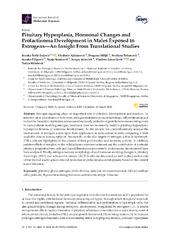Приказ основних података о документу
Pituitary Hyperplasia, Hormonal Changes and Prolactinoma Development in Males Exposed to Estrogens — An Insight From Translational Studies
| dc.creator | Šošić-Jurjević, Branka | |
| dc.creator | Ajdžanović, Vladimir | |
| dc.creator | Miljić, Dragana | |
| dc.creator | Trifunović, Svetlana | |
| dc.creator | Filipović, Branko | |
| dc.creator | Stanković, Sanja | |
| dc.creator | Bolevich, Sergey | |
| dc.creator | Jakovljević, Vladimir | |
| dc.creator | Milošević, Verica | |
| dc.date.accessioned | 2020-03-18T09:49:54Z | |
| dc.date.available | 2020-03-18T09:49:54Z | |
| dc.date.issued | 2020 | |
| dc.identifier.issn | 1422-0067 | |
| dc.identifier.uri | internal-pdf://ijms-21-02024.pdf | |
| dc.identifier.uri | https://radar.ibiss.bg.ac.rs/handle/123456789/3618 | |
| dc.description.abstract | Estrogen signaling plays an important role in pituitary development and function. In sensitive rat or mice strains of both sexes, estrogen treatments promote lactotropic cell proliferation and induce the formation of pituitary adenomas (dominantly prolactin or growth-hormone-secreting ones). In male patients receiving estrogen, treatment does not necessarily result in pituitary hyperplasia, hyperprolactinemia or adenoma development. In this review, we comprehensively analyze the mechanisms of estrogen action upon their application in male animal models comparing it with available data in human subjects. Sex-specific molecular targets of estrogen action in lactotropic (PRL) cells are highlighted in the context of their proliferative and secretory activity. In addition, putative effects of estradiol on the cellular/tumor microenvironment and the contribution of postnatal pituitary progenitor/stem cells and transdifferentiation processes to prolactinoma development have been analyzed. Finally, estrogen-induced morphological and hormone-secreting changes in pituitary thyrotropic (TSH) and adrenocorticotropic (ACTH) cells are discussed, as well as the putative role of the thyroid and/or glucocorticoid hormones in prolactinoma development, based on the current scarce literature. | en |
| dc.relation | info:eu-repo/grantAgreement/MESTD/Basic Research (BR or ON)/173009/RS// | |
| dc.rights | openAccess | |
| dc.rights.uri | https://creativecommons.org/licenses/by/4.0/ | |
| dc.source | International Journal of Molecular Sciences | |
| dc.subject | Pituitary gland | |
| dc.subject | Estrogen | |
| dc.subject | Prolactinoma | |
| dc.subject | Men | |
| dc.subject | Rat | |
| dc.subject | Microenvironment | |
| dc.subject | Folliculo-stellate cells | |
| dc.subject | Prolactin | |
| dc.subject | Thyroid-stimulating hormone | |
| dc.subject | Adrenocorticotropic hormone | |
| dc.title | Pituitary Hyperplasia, Hormonal Changes and Prolactinoma Development in Males Exposed to Estrogens — An Insight From Translational Studies | en |
| dc.type | article | en |
| dc.rights.license | BY | |
| dcterms.abstract | Милошевић, Верица; Јаковљевић, Владимир; Болевицх, Сергеy; Станковић, Сања; Шошић-Јурјевић, Бранка; Aјджановић, Владимир; Миљић, Драгана; Трифуновић, Светлана; Филиповић, Бранко; | |
| dc.rights.holder | © 2020 by the authors | |
| dc.citation.issue | 6 | |
| dc.citation.volume | 21 | |
| dc.identifier.doi | 10.3390/ijms21062024 | |
| dc.identifier.scopus | 2-s2.0-85082087099 | |
| dc.identifier.wos | 000529890200120 | |
| dc.citation.apa | Šošić-Jurjević, B., Ajdžanović, V., Miljić, D., Trifunović, S., Filipović, B., Stanković, S., et al. (2020). Pituitary Hyperplasia , Hormonal Changes and Prolactinoma Development in Males Exposed to Estrogens — An Insight From Translational Studies. International Journal of Molecular Sciences, 21(6), 2024. | |
| dc.citation.vancouver | Šošić-Jurjević B, Ajdžanović V, Miljić D, Trifunović S, Filipović B, Stanković S, Bolevich S, Jakovljević V, Milošević V. Pituitary Hyperplasia , Hormonal Changes and Prolactinoma Development in Males Exposed to Estrogens — An Insight From Translational Studies. Int J Mol Sci. 2020;21(6):2024. | |
| dc.citation.spage | 2024 | |
| dc.type.version | publishedVersion | |
| dc.identifier.fulltext | https://radar.ibiss.bg.ac.rs/bitstream/id/6031/ijms-21-02024.pdf | |
| dc.citation.rank | M21 |

